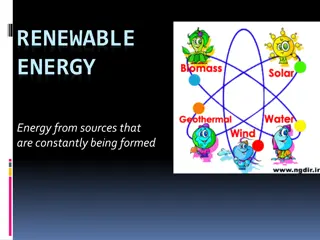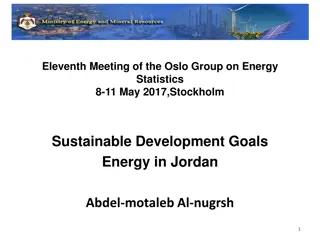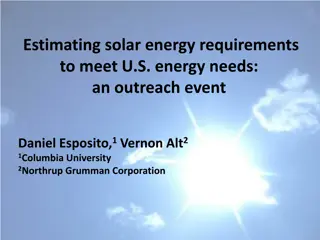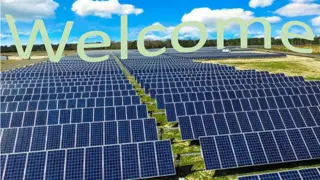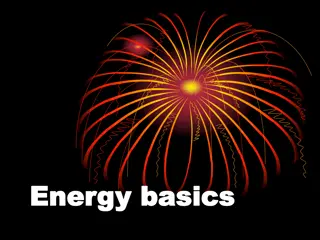Understanding Energy and Power: A Comprehensive Guide
Explore the concepts of energy, power, and electricity consumption, including definitions, equations, units of measurement, and examples. Learn about watts, kilowatt-hours, and how lighting impacts residential energy usage. Discover how different light bulbs work and their efficiency. Delve into the production of light through incandescence and fluorescence, and compare various types of light bulbs. Gain insights into global energy usage and the significance of electricity in our daily lives.
Download Presentation

Please find below an Image/Link to download the presentation.
The content on the website is provided AS IS for your information and personal use only. It may not be sold, licensed, or shared on other websites without obtaining consent from the author. Download presentation by click this link. If you encounter any issues during the download, it is possible that the publisher has removed the file from their server.
E N D
Presentation Transcript
Consumer Preferences August 18, 2013
What is Power? Power is the rate at which work is performed. Equations: ????? = ???? ???????????? ???? = ????? ???????? ????? = ???? ????
What are the units of Force, Work, and Power? Force: Newton (N) 1 ? = 1?? ? ?2 Work: Joule (J) 1 ? = 1 ? ? Power: Watt (W) 1 ? = 1? ? where kg=kilogram, m=meter, s= second
What is a Watt? Example: Suppose a man, who has a mass of 70 kg, needs to climb a 5-meter high wall in 6 seconds. How much work would he do and how much power would he need to accomplish this feat? 4
Hold on! What is energy? Energy is Work. One way to measure Energy is to measure the amount of power in a certain time period. kWh is the most common unit used to express the amount of electricity, especially for billing purposes. 1 KWh = 1000 W-h 1 kWh = 3.6 MJ MWh are sometimes used when describing energy from a power plant. Example: How much electricity is consumed by a 60 W light bulb operating for one hour?
US v.s. World Energy Use On average, how much electricity is used per person per year in the US? How about in other countries? 6
US Residential Energy Usage Lighting accounts for 10 to 15 % of residential Energy usage! 7
Lighting Experiment Compare the light bulbs
How is our lighting produced? Incandescence Light emitted due to high temperature Color of the light is determined by the temperature of the object. Figure Courtesy of 123rf Fluorescence Highlighter UV light at museums, etc. 9 Figure Courtesy of NASA
Lets have a look at light bulbs Incandescent vs. Compact Fluorescent Light Heat Brightness (Lux) Color comparison 1. Soft white (2700K) 2. Bright white (3500K) 3. Daylight (5000K) 10
Lighting technologies Incandescent lamp Less than $1 11 Source: http://visual.merriam-webster.com/house/electricity/lighting/incandescent-lamp.php
Lighting technologies Fluorescent lamp Around $2 ~$5 Tubular Fluorescent Lamp Compact Fluorescent Lamp (CFL) 12 Source: http://motohata.com/2011/05/10/fluorescent-lamps-energy-efficient/
Lighting technologies Light Emitting Diode (LED) Around $20 ~$40 Source: http://www.gadgetvenue.com/geobulb-led-light-bulb-costs-120-03305214/ http://www.metaefficient.com/bicycles/bright-led-bike-light.html 13
How are they similar? Overlapping range of color Incandescent Incandescent vs. Compact Fluorescent Lamp (CFL) CFL Almost identical in terms of brightness Ranging from 350 lm to 1800 lm Luminous flux (Lumen, lm) Total light output from a source Illuminance (Lux, lx) From the perspective of a receiver Light input per unit surface area (1 lx = 1 lm/m2 ) 14
How are they different? CFLs, compared with incandescent lamps, last about nine to ten times longer. use less energy. Incandescent: About 5% of input energy is converted to light. CFL, LED: About 20% is converted to light. (4x) The rest is wasted as heat. are more expensive. contain mercury. 15
Which is better? - Economics High price and low energy cost (CFL) vs. Low price and high energy cost (Incandescent) Lifetimematters! 16
Which is better? Mercury risk Mercury It can damage the central nervous system, kidneys, and liver. CFLs contain small amount of mercury (4~5mg). Largest source: coal-fired power plants (50% of total in the U.S.) 17
Lighting Experiment Compare the light bulbs
Additional Choice Task #1 Please answer these three questions and write what you think during the process. For example, Was it hard because of too many factors? Did you look at just a couple things and ignore others? 19
U.S. legislation on lighting efficiency Energy Independence and Security Act of 2007 (EISA) Mandates that all light bulbs be 30% more efficient in 2012 and 60% more efficient in 2020 Incandescent bulbs will be subject to higher energy efficiency standards Better Use of Light Bulbs (BULB) Act Tried to repeal EISA but was not successful The House voted it down on 7/12/2011. A massive Big Brother intrusion into our homes and our lives. - Member of the U.S. House of Representatives 22







